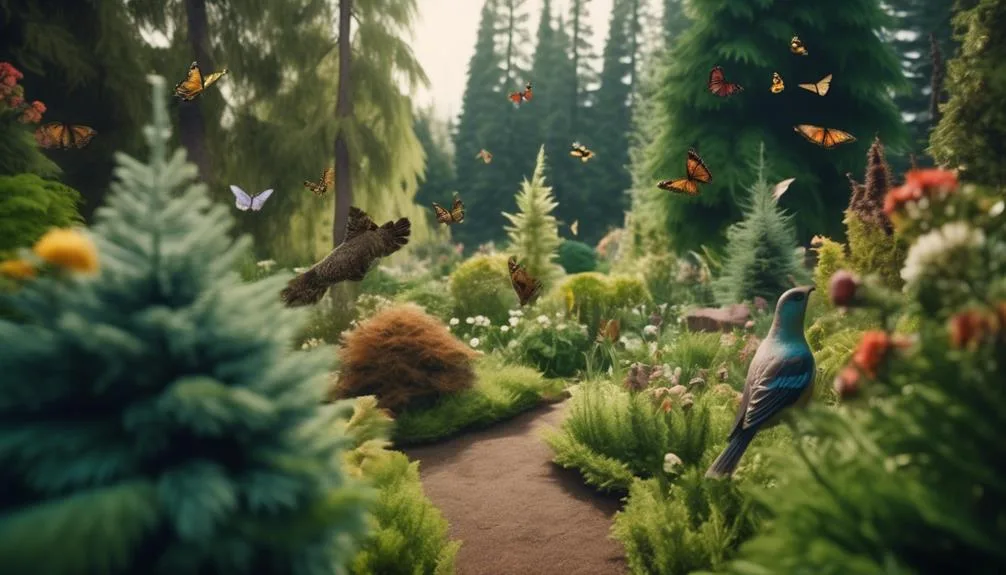Over 80% of North American wildlife relies on trees for survival.
If you want a wildlife-friendly garden, consider adding spruce trees. They offer food, shelter, and year-round beauty for animals.
With many types available, it's essential to choose the best ones for supporting wildlife.
Let's explore the features and benefits of different spruce trees to help you decide which is best for your garden.
Benefits of Spruce Trees for Wildlife
Spruce trees provide essential shelter, sustenance, and protection for a diverse array of wildlife in your garden. Their dense foliage and sturdy branches attract insects, creating a thriving ecosystem. Insects are vital for pollination and are a food source for many other animals, making spruce trees crucial for supporting pollinators and the entire food chain in your garden.
The presence of spruce trees also offers nesting sites and safe havens for birds and small mammals, contributing to the overall biodiversity of your garden. Furthermore, the year-round greenery of spruce trees ensures continuous cover and foraging opportunities, making them an attractive habitat for wildlife.
Characteristics of Wildlife-Friendly Spruce Trees
With their dense foliage and sturdy branches, spruce trees create an inviting habitat for a variety of wildlife in your garden. When it comes to tree species selection for wildlife-friendly landscaping, spruce trees stand out for their ecological balance.
Their evergreen nature provides year-round shelter and protection for birds, small mammals, and insects. The dense foliage offers nesting opportunities for birds, while the sturdy branches provide secure perches. Additionally, the cones produced by spruce trees serve as a food source for various animals, contributing to the overall wildlife habitat.
These characteristics make spruce trees an excellent choice for creating a biodiverse and wildlife-friendly garden. By incorporating spruce trees into your landscaping, you can help support and maintain a healthy ecosystem in your outdoor space.
Best Spruce Trees for Attracting Birds
If you're aiming to draw more feathered friends to your garden, consider the diverse array of spruce trees that offer an inviting haven for birds seeking shelter, nesting sites, and food sources. The following spruce trees are excellent choices for attracting birds, providing not only a safe habitat but also enhancing bird watching opportunities in your wildlife-friendly garden. When selecting a spruce tree for bird attraction, consider its environmental impact and the placement in your garden to maximize its benefits. Placing bird feeders near these trees can further encourage bird visits.
| Spruce Tree | Environmental Impact | Tree Placement |
|---|---|---|
| Colorado Spruce | Provides shelter and | Place near bird feeders |
| nesting sites | for easy access | |
| Norway Spruce | Offers ample food | Plant in open spaces for |
| sources for birds | easy bird access | |
| Blue Spruce | Attracts various bird | Position to provide shade |
| species with its | and cover for birds | |
| dense foliage |
These spruce trees not only enhance the beauty of your garden but also contribute to a thriving bird-friendly environment.
Spruce Trees Providing Shelter for Small Mammals
Consider how small mammals find refuge and safety within the dense foliage and sturdy branches of spruce trees in your wildlife-friendly garden.
These trees offer ideal wildlife habitats for small mammals such as squirrels, chipmunks, and voles. The thick evergreen foliage provides excellent cover and protection from predators, while the strong, interlocking branches create a secure environment for nesting and shelter.
By providing tree shelters, spruce trees contribute to the ecosystem diversity of your garden, supporting a thriving community of small mammals. The presence of these animals also attracts predators like owls and foxes, further enriching the biodiversity of your garden.
Thus, incorporating spruce trees not only enhances the aesthetic appeal of your garden but also fosters a balanced and flourishing wildlife ecosystem.
Enhancing Biodiversity With Spruce Trees
Spruce trees contribute significantly to the biodiversity of your garden, fostering a balanced and flourishing ecosystem. By planting spruce trees, you can enhance the biodiversity of your garden and support a thriving ecosystem. Here's how spruce trees can help enhance biodiversity:
- Tree Planting
Planting spruce trees provides a diverse range of habitats for various wildlife species, including birds, insects, and small mammals. These trees offer nesting sites, shelter, and food sources, contributing to the overall biodiversity of your garden.
- Ecosystem Balance
Spruce trees play a crucial role in maintaining the balance of your garden's ecosystem. They provide shade, help regulate temperature, and support the growth of other plants, creating a harmonious environment for a wide range of wildlife. This balance is essential for a healthy and diverse ecosystem.
Conclusion
Selecting the right spruce trees can significantly enhance your garden's ecosystem by providing food, shelter, and nesting sites for birds, as well as habitat for small mammals.
By fostering biodiversity, your garden can become a thriving environment for wildlife.
Happy gardening, and may your garden be a haven for nature's beauty.

My interest in trees started when I first saw the giant sequoias in Yosemite.
I was a teenager then, and I remember thinking, “I need to learn more about this.”
That moment stuck with me.
A few years later, I went on to study forestry at Michigan Tech.
Since graduating, I’ve worked in a mix of hands-on tree care and community education.
I’ve spent over ten years helping people understand how to plant, maintain, and protect the trees in their neighborhoods.
I don’t see trees as just part of the landscape.
They are living things that make a real difference in our daily lives.
